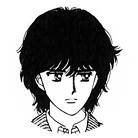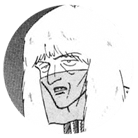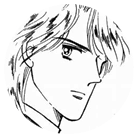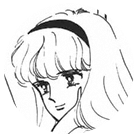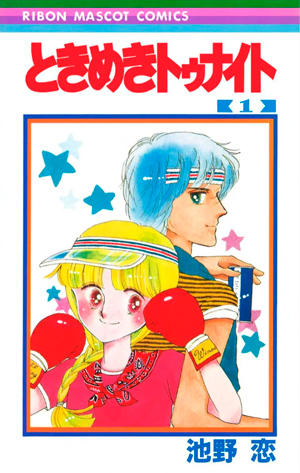
Ranze arc
Etō Ranze is the heroine of the first arc of Tokimeki, and arguably the most popular heroine of the series. She is the daughter of a vampire father and a werewolf mother, and her family is originally from "Makai" (the term used in the series for a world where monsters live), but grew up in the human world. She meets the love of her life, Makabe Shun, when she enrols in middle school at the age of 14, and shortly after, she manifests her supernatural ability: whenever she bites someone, she turns into them! The first arc of the manga, which is also its longest (with 58 chapters, one 100-page extra chapter, and six side stories), follows Ranze and her both wacky and dramatic adventures.
Story
The Ranze arc is not officially divided into further arcs, but in broad strokes the story covers the following four plot threads. This section features heavy spoilers.
Part one: Ranze's school days
Ranze enrols in middle school, meets Makabe Shun, and also meets her eternal rival Kamiya Yōko. The story follows the previously home-schooled Ranze as she learns to socialize with her peers, falls in love, makes friends, and attends school events such as the school sports festival and a school trip to the seaside. It's also revealed that there is a prince of Makai living in the human world, and Ranze's father Mōri is ordered by the king of Makai to find him; when his novel Super Cape is turned into a feature film, Mōri uses the audition process for the lead role to look for the prince, leading to many funny hijinks. It's an immensely fun read, although nowhere near as dramatic as Tokimeki would later become. Many of the principal characters, who will continue to play important roles in the plot throughout the series, are already introduced here: Ranze's parents and her brother Rinze, Rinze's girlfriend Narumi (who will become the heroine of the second arc), Prince Aron, Sand, the grim reaper George, the king of Makai, the witch Moevius, and so on.
Part two: the twin princes
The dramatic plot of Tokimeki kicks in with the reveal that Shun is the exiled prince of Makai, and the twin brother of Aron. Ranze goes on the run with Shun, who has reverted back to a baby, to protect him from the king of Makai. The entire Etō family becomes traitors to the throne as the king tries to hunt down Shun and kill him. It's a roller-coaster ride of an arc, the plot moving along at a brisk pace every chapter, and characters such as Shun and Aron are fleshed out while we come to love Ranze even more for her strength and agency during trying times.
Part three: 2000 years ago
Ranze and Shun return to the human world after the ordeal, but are soon pulled into another conflict: in Makai, a mysterious legendary hero is resurrected, and claims that she was slain by the "evil prince" 2000 years ago — a prince who looks exactly like Shun, and married a woman who looks just like Ranze. Concurrently, Ranze meets a Romanian mafia boss through Shun's dream, who turns out to be a descendant of the "evil prince". What actually happened 2000 years ago? Who is the true enemy? This is an amazing arc, with legends and mystery and twists and turns all the way through. Dirk Carlos is a great, fan-favorite addition to the cast.
Part four: the five rings
After defeating the enemy, Ranze and Shun return to the human world once again — but their relationship has forever been altered, because Shun has become a human. They attend high school together, joined by Yōko (and we see a return of Ranze's middle-school friend Kaede), and Shun goes back to boxing. But can Ranze and Shun overcome their differences? And can they collect the five mysterious rings, which are said to give the wearer the power to rule over all five worlds? This, again, is an amazing arc: the focus is much more on the romance between Ranze and Shun, which is a love story all fans of Tokimeki have been dying to read. The storyline set in high school is great, with amazing new cast members Yurie and Hino. Yōko is at her best, too, and we get to see how much she loves Shun, as well as how much she has genuinely come to care about Ranze as a friend. Ikeno's art in this arc, I think, is the best of her career.
Characters
|
|
|
|
|
|
|
|
|
|
|
|
|
|
|
|
|
|
Note: There are some foreign/Makai names where I've made up the spelling, because it's not made clear in the text.
Side Stories
Six side stories for the Ranze arc were published during its serialization. While most of them are comical and have very little bearing on the main plot of the series, they are all quite fun. Although the last side story written before Tokimeki shifted over to featuring Narumi as the heroine, called Christmas no okurimono, is an absolute must-read for fans as it provides closure for the romance between Ranze and Shun.
Nemuri no mori no bijo futari!? (Two Sleeping Beauties!?)
Originally published in the summer "extra" issue of Ribon in 1983. This is a comedic parody of the Sleeping Beauty fairy tale, in which both Ranze and Yōko are sleeping beauties. The characterization is from quite early on in the series, so especially Shun acts a little off, but it's a fun little story. I especially like the punch line.
Yōko wa makai-jin!? (Yōko is a Monster!?)
Originally published in the spring "extra" issue of Ribon in 1984. This is a short comedic manga about what would happen if Yōko gained Ranze's ability. Great fun read if you like Yōko (and who doesn't?).
Panic! Etō-gumi vs. Kamiya-gumi (Panic! Etō Family vs. Kamiya Family)
Originally published as a furoku booklet to the September 1985 issue of Ribon. Set during the time when Shun was living with the Etō family, this one-shot focuses on Yōko's love life! She meets her fiancee, Riki, who will come back again in the Narumi arc of the series. The love story between the two is a great read, and I think this story showcases just how cool and strong a character Yōko is. The B plot about the Etō family and the Kamiya family (the mobster kind of family!) being at war is also fun, especially when Mōri and Shiira gather monsters from Makai in order to defeat the Kamiya family. And Ranze looks stunning in a kimono.
Kagami no kuni no Ranze (Ranze Through the Looking-Glass)
Originally published as a furoku booklet to the June 1986 issue of Ribon. I believe this is set close to the end of the Ranze arc, and is about Ranze and Rinze discovering a new room in their basement. It has three mirrors: one to make you older, one to make you younger, and one that will take you to a mirror universe where everything is reversed. It mostly focuses on Ranze realizing what it is about Shun she loves, through meeting his exact opposite — outwardly kind and a gentleman, but weak-willed and cowardly — in the mirror universe. It's a great story, and the bits about Rinze becoming older (he's such a handsome teen!) and Ranze becoming younger (such a cute kid!) is a ton of fun, too.
Summer Dream Island
Originally published in the September 1987 issue of Ribon. After the end of the Ranze arc, Ranze, Shun, Rinze, Narumi, and Yōko (who butts in, of course!) takes a summer vacation on a tropical island. They meet and befriend a couple from the local population, and help them get together against all the odds. It's a fun, sweet story.
Christmas no okurimono (The Christmas Gift)
Originally published in the December 1987 issue of Ribon. This is the definitive Tokimeki side story, and the true conclusion to the Ranze arch. After the end of the series, Ranze becomes unsure whether Shun really loves her and will marry her, so she goes down to the basement and through the door to the future. There, she meets and befriends a young boy — Shun's future son. It's an amazing story, packed with emotion, and a must-read for any fan who followed the story of Ranze and Shun through thick and thin.
-
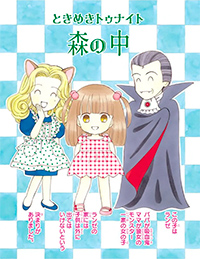
- Mori no naka title page
Mori no naka (In the Woods)
This six-page, full-color picture book style story was published in the summer 2006 edition of Amigo, an "extra" issue of Ribon for little kids, and later collected in the Etō Ranze no takarabako tankōbon. It's about Ranze running away from home as a child because she wants to make friends to play with rather than playing in the mansion by herself, and getting lost in the woods. The art is absolutely adorable and the coloring beautiful.
Itsumo tokimeite (Always with a fluttering heart)
This is a sequel that was published in 2009 to commemorate Ikeno's 30th anniversary as a manga artist. It takes place at a party to commemorate Mōri's 40th anniversary as a novelist, quite a few years into the future when Aira is already an adult. It's about all the characters, but ends with Shun and Ranze watching the newly-released DVD box of the Tokimeki anime and reminiscing about their past. We learn that Ranze is a famous housewife blogger, and that Yōko has been elected a member of the city council, which I thought was very cool (although the story itself is pretty silly). This one-shot is available in Ikeno's if no frame tankōbon.
Makabe Shun no jijō and others...
A series of direct-to-tankōbon prequels and sequels have been published since 2013. Please see the dedicated page for more information.
Novels

Between 1993 and 1994 (while the Aira arc was running in Ribon), the Ranze arc of Tokimeki was adapted into a five-volume novel series by Tanaka Masami. It was published by Shueisha's Cobalt imprint which specializes in light novels for girls. At this time, Cobalt featured a series called "Pinky", which published novelizations of new and old shōjo manga chiefly from Ribon and Margaret magazine; other titles adapted from manga around this time include Ikeno's Ririka SOS, Yazawa Ai's Neighborhood Story, Kamiya Yōko's Boys Over Flowers, and many more.
The five volumes published cover the story of Tokimeki from the beginning until the point where Ranze is trapped in the past and believes Shun has died, ending in a cliffhanger. I'm not sure why the series wasn't continued, since the Pinky series of novelizations continued until early 1998, although it might simply not have sold well enough.
All five volumes have covers with new color art drawn by Ikeno, and features two color frontispieces as well as around ten pages of black and white illustrations. Volumes 1, 2, and 5 feature two new pieces of color art by Ikeno as the frontispieces, while volumes 3 and 4 contain one new color art and one reprint of an old title page from Ribon (from chapters 9 and 13). The new pieces of art are quite cute, especially the cover art, but it was also a pleasant surprise to see the reprints!
The writing by Tanaka Masami is adequate. I'm not much of a light novel fan, to be honest, so I only skimmed these volumes. It seems to be standard light novel/Cobalt fare, with big white spaces at the bottom of the pages.
Trivia
- The name "Etō Ranze" is a play on the French word "étranger", meaning "foreigner". It's transcribed as エトランゼ in Japanese, which reads "etoranze".
- Two pages from chapter 2 were accidentally reversed in the magazine run in 1982. The scene makes perfect sense with the pages reversed, and this mistake wasn't corrected until the publication of the shinsōban edition in 2011, almost 30 years later.
-
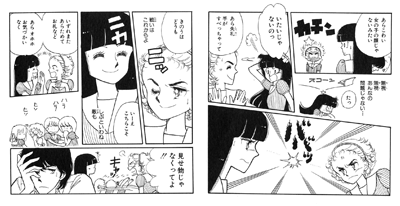
- Wrong order (original magazine, tankōbon, and bunko)
-
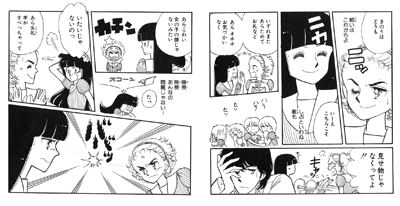
- Correct order (shinsōban)
-
- Ikeno failed to meet her deadline once during the serialization of the Ranze arc, in the January 1987 issue of Ribon. This was only four months before the conclusion of the Ranze arc, and the dramatic tension was at its peak. The previous chapter had ended in a cliffhanger, with Ranze, Shun, and Yōko about to be crushed under a pile of falling rocks. Instead of a new chapter, a page featuring Ikeno apologizing and Ranze complaining about the rocks in the background was printed in the magazine.
- No matter how dramatic and serious the story of Tokimeki became, its tagline in Ribon magazine was "Hilarious! Transformation Comedy". (The Narumi arc's tagline was "Hilarious! Supernatural Comedy", while the Aira arc's tagline was "The No. 1 Supernatural Family Comedy in Japan", finally moving away from "hilarious".)
- Ikeno Koi has often spoken about how her favorite manga artist is Hagio Moto, and how Poe no ichizoku (The Clan of Poe, a seminal shōjo manga about a clan of vampires) is one of the manga that has left the biggest impression on her. Given this, doesn't it make sense to think that the name of Raze's mother "Sheila" comes from the name of the mother in Poe no ichizoku, and that Ranze's grand uncle "Toma" comes from the title character of Hagio's The Heart of Thomas? And maybe "Mōri", Ranze's father, is from Julusmole? Fun to think about!
Contemporaries
The serialization of Tokimeki in Ribon coincides with a period in Ribon's publication history when many other popular and influential shōjo series were being serialized as well. Here is a selection of popular titles that ran alongside the Ranze arc.
-
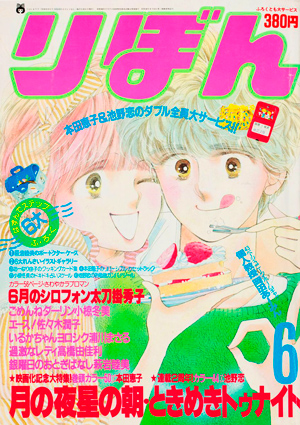
- June 1984 issue of Ribon prominently featuring Tsuki no yoru and Tokimeki
- Tsuki no yoru, hoshi no asa by Honda Keiko: During the first half of the Ranze arc, Tokimeki and Tsuki no yoru were the top two series of Ribon. It was even turned into a live-action movie in 1984. It's a series about a romance between two childhood friends.
- Hoshi no hitomi no silhouette by Hiiragi Aoi: The first long-running series by Hiiragi, this romance about a group of six friends became so popular that its tagline was "the bible of two million girls" (because the circulation of Ribon at the time climbed to such a high). During the latter half of the Ranze arc, Tokimeki and Hoshi no hitomi were the top two series of Ribon. It captured a broad audience of both sexes, and is still considered a legendary series by shōjo manga fans in Japan.
- Gin'yōbi no otogibanashi by Hagiiwa Mutsumi: Through the 80s and 90s, Hagiiwa drew many heartwarming series about fantasy creatures and adorable animals. This was her first long-running series and her most popular, and it's about Poe, a princess of the little people living in the woods of England, who moves to London with her best friend Lilfy, a bird, and befriends Scott, a human artist. Hagiiwa's art is, I believe, some of the best and most skilled that has ever been published in Ribon magazine, and to this day she is still beloved by fans and has shown her colored artwork at exhibitions.
- Otōsan wa shinpaishō by Okada Amin: Although she has been inactive since 1997, Okada is still considered by many to be one of the great geniuses of shōjo manga comedy. Her first series, about a father who is so overprotective of his daughter that he goes crazy every time she even mentions her boyfriend, became a hit with a broad audience because of its extreme, envelope-pushing comedy of a kind that was rarely seen in shōjo manga before Okada. It was turned into a TV mini series in 1994, six years after its conclusion.
-
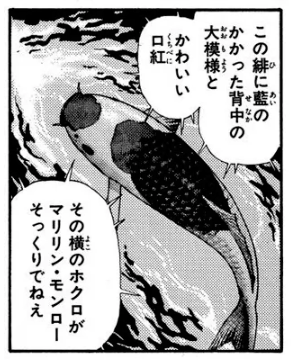
- Eponymous "ike no koi"
- Yūkan Kurabu by Ichijō Yukari: Ichijō is one of the giants of shōjo manga, up there with the likes of Ikeda Riyoko (Rose of Versailles) and Miuchi Suzue (Glass Mask), and this long-running, fan-favorite series of comedic action/mystery/horror manga first appeared in Ribon Original (an "extra" issue of Ribon published between 1981 and 2006) in 1981, and in Ribon proper in 1982. It continued as a series of one-shots and short series until 2002, and was turned into a TV drama in 2007. It's a great, fun series showcasing Ichijō's more lighthearted side, and features a group of iconic characters. Trivia: it has a chapter called "Abduction of ike no koi (i.e. the carp in the pond)", referencing the pun in Ikeno Koi's name.
As its contemporary series referenced Tokimeki, Ikeno also made references to a few series running in Ribon at the time (both from Tokimeki vol. 11):
- Ikeno draws the king of Makai being conjested and cracks the joke "Otōsan wa chikunōshō (dad has empyema)", a pun on the title Otōsan wa shinpaishō by Okada Amin:
-

- "Otōsan wa chikunōshō"
-
- Ikeno draws a cameo appearance by "Rūko", the main character of Takahashi Yukari's track and field manga Namida no rikujōbu, and cracks the joke that Tokimeki is now a sports manga called "Tokimeki rikujōbu":
-
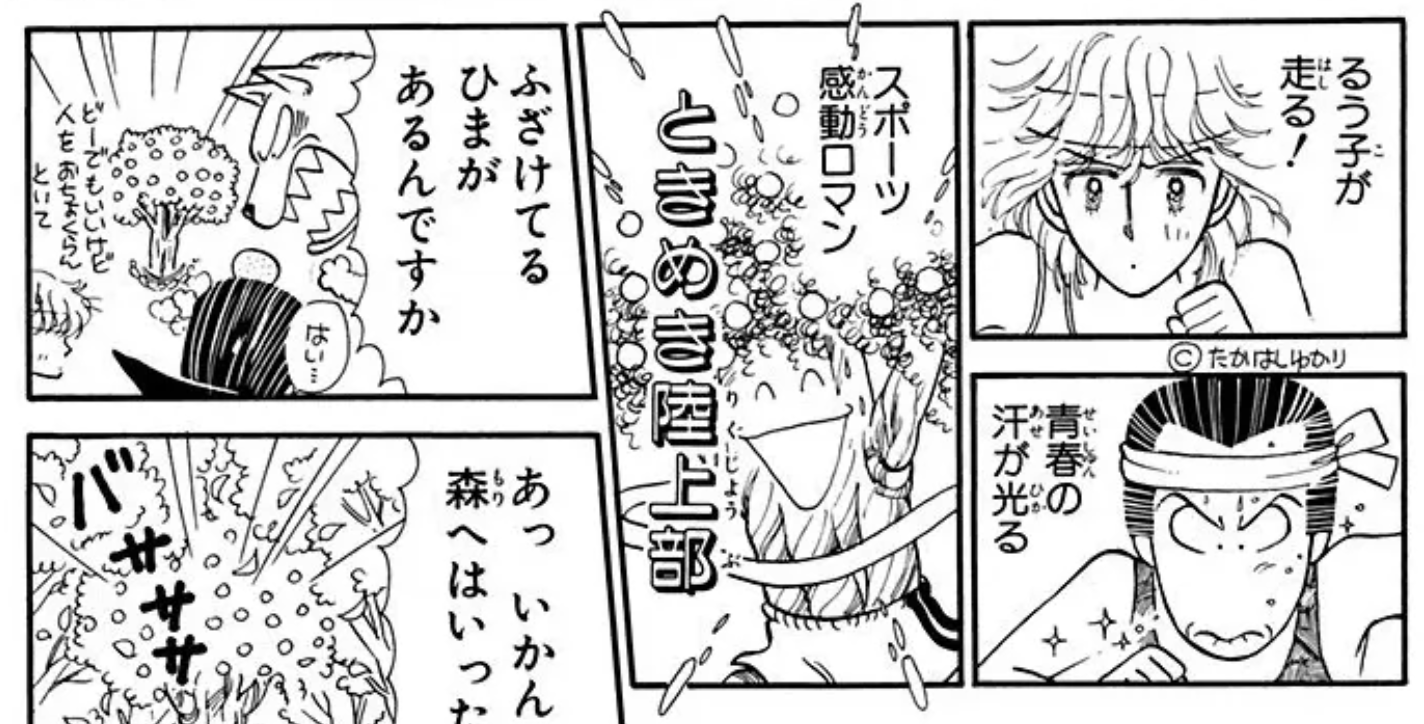
- "Tokimeki rikujōbu"
-
Availability
Because the Ranze arc is by far the fan-favorite of Tokimeki's run, many editions of it have been published through the years.
Ribon Mascot Comics tankōbon (1982-1988)
The Ranze arc covers volume 1 to 16 of the original tankōbon release of the manga. The main storyline concludes midway through volume 15, and the rest of the volume and volume 16 contain the six side-stories written during the serialization. The tankōbon edition is out of print, but was made available as ebooks in 2013, e.g. at eBookJapan and the Amazon Kindle store.

Shueisha bunko (1998-1999)
Volumes 1-7 of the bunko edition include the entire run of the Ranze arc, and volume 8 includes the six side-stories.
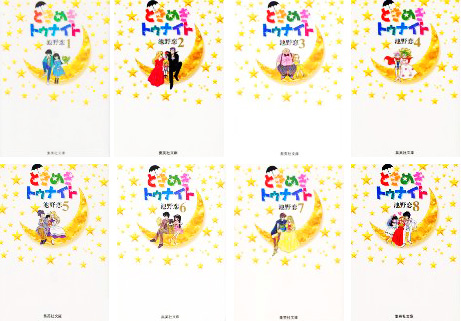
Shueisha Girls Remix (2002-2004)
With many of their popular titles, Shueisha puts out "remix" editions printed on magazine-quality paper and containing ads to be sold for cheap at convenience stores. This eight-volume edition also includes some short articles, such as character profiles and pages with furoku from the Ranze arc, which could have been fun but are sadly printed in black and white. This edition is also abridged, so it's not something I'd pick up for a first-time reader. It is out of print.
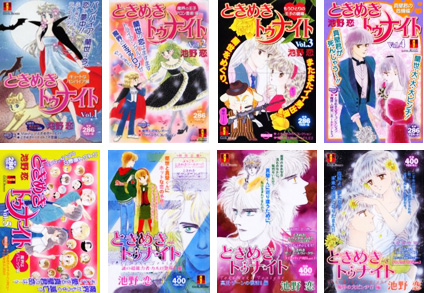
RMC shinsōban (2011-2012)
A 12-volume revised edition of the Ranze arc has been released. They feature new cover art by Ikeno, and tribute manga by artists currently working in Ribon as well as Shinjō Mayu and Peach-Pit. This edition does not feature any of the side-stories, which I personally think is too big of a failing to ignore, but they do look pretty! They also contain little "behind the scenes" drawings by Ikeno, and the last volume features a manga essay by Ikeno.
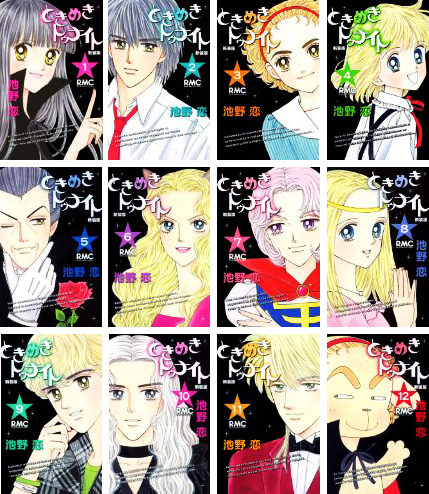
Italian edition
The Tokimeki anime seems to have been quite popular in Italy, and the entire manga series was released in Italian from the publisher Star Comics under the title Batticuore Notturno — Ransie La Strega (which I believe translates to Heartbeat Tonight — Ranze the Witch). The Italian edition seems to follow the original Japanese tankōbon release, meaning vol. 1-16 cover the Ranze arc including the side stories. According to amazon.it these are out of print, but probably available used. A great opportunity if you speak Italian!
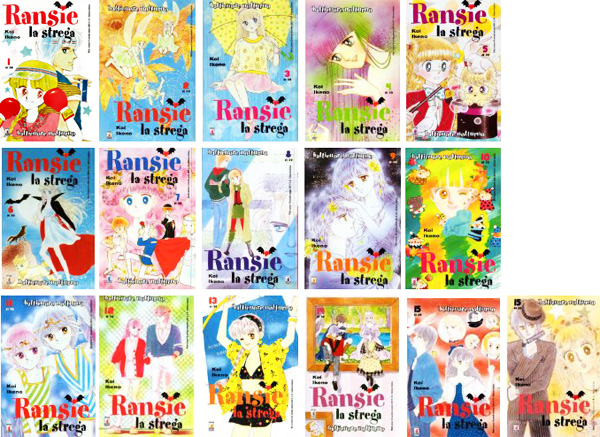
Indinesian edition
Tokimeki was published in Indonesia by Elex Media Komputindo Publisher under the title Throbbing Tonight. The Indonesian edition follows the Japanese tankōbon release, meaning vol. 1-16 cover the Ranze arc, and even uses the same images for its covers. I've been told it was very popular!

Thank you so much to Dio for scans and information about the Indonesian version!
Other editions
I don't speak any of these languages, but here are some other language editions I've found while googling: Thai, Chinese, unknown language.
Fan translation
An English-language fan translation of the first six volumes is available online.

